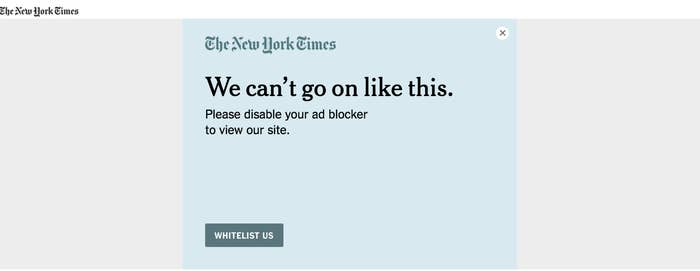The New York Times is the latest digital news operation to declare war on ad-blockers, with some users now unable to access its website without first disabling their ad-blocking software.
"We can't go on like this," the Grey Lady is warning users via pop-up.

The popups are "tests" that are only affecting "small segments of our audience," Eileen Murphy, a New York Times spokesperson, told BuzzFeed News. The pop-ups do not appear to be distinguising between paid Times subscribers who are logged into the site and visiting non subscribers.
Mark Thompson, the chief executive officer of the Times, said on an earnings call in October that the company was considering a "technical solution" to the rise of ad-blockers. “Let me make it clear that we oppose ad blocking,” he said. “The creation of quality news content is expensive and digital advertising is an important way in which we and other high-quality news providers fund operations.”
"At the moment we're simply testing various options and encouraging Times readers using ad blockers to whitelist the site," Murphy told BuzzFeed News.
According to Adblock, there were 15 ads on the Times homepage on Tuesday afternoon, including a banner ad across the top of the page that featured an auto-playing video. Ghostery, a tool that monitors code inserted in webpages to track user behavior and collect data for advertisers and others, said 25 such "trackers" were active on the homepage.
The NYTimes just asked me to turn off my ad-blocker. I PAY REAL MONEY for the Times.
In its most recent quarter, the Times had $50 million in revenue from digital subscriptions and $70 million of revenue from digital advertising, with $205 million in total advertising revenue and $213 million in total circulation revenue.
Other websites have employed various measures to discourage ad-blocking, from polite requests (Slate, The Guardian, The Atlantic) to occasional blocks (The Washington Post), charging for individual articles (GQ), and not letting readers with active ad-blockers read the website at all (Forbes).
Wired, which said in February that 20% of its traffic comes from readers with ad-blockers, allowed readers who whitelisted the site to view a version with "only standard display advertising" or to subscribe to an ad-free version of Wired.com for $1 a week.
